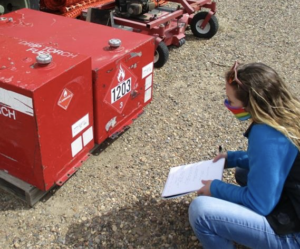 When audits are initiated in response to an outside requirement to perform an audit, simply obtaining a competent audit at a competitive cost may be the perfect solution. In these cases, audit quality isn’t as much of a concern as clearing the pass-fail bar as efficiently as possible. Of course, the audit must be performed in a professional manner and the results need to be adequately documented in a report. The federal government would call this the “lowest cost, technically acceptable” standard. If this sounds like you, your path forward is fairly clear and you should probably skip over the rest of this post.
When audits are initiated in response to an outside requirement to perform an audit, simply obtaining a competent audit at a competitive cost may be the perfect solution. In these cases, audit quality isn’t as much of a concern as clearing the pass-fail bar as efficiently as possible. Of course, the audit must be performed in a professional manner and the results need to be adequately documented in a report. The federal government would call this the “lowest cost, technically acceptable” standard. If this sounds like you, your path forward is fairly clear and you should probably skip over the rest of this post.
For those who actually want an environmental compliance audit for their own — perhaps more nuanced — reasons, pinning down the value of an audit can be more complex. The best starting place is often to define why you want an environmental compliance audit at all. These reasons (or goals) should be documented and discussed with the team that is planning the audit or audit program to be sure everyone agrees on the point of it all (spoiler alert: They probably don’t). Once you have clarified why you want an audit, you might ask yourselves some questions like these examples:
- Am I completely confident deficiencies identified in our audits are applicable and accurate?
- I want to be confident we uncover as many of our compliance deficiencies as possible, so does our audit approach provide that level of investigation?
- Do our audits tell me if our internal training and directives are being implemented fully?
- Do our auditors have the experience to reveal underlying causes of noncompliance, or are we simply fixing what’s wrong today?
- Do our audits provide guidance on how to correct compliance deficiencies to our facility personnel?
- Do our managers and staff believe our audit process is reliable, respectful, and professional?
- How can I maximize the information transfer (training) our operations managers and facility staff receive during and after our audits?
- Are written audit results prepared in a way that promotes understanding of requirements, builds confidence in the audit process, and simplifies corrective actions?
Environmental compliance audit programs can offer great benefits, but organizations must consider what they want out of the program and decide what audit approach really offers the best value.


 I had the opportunity, over four days, to walk through the neighborhoods of Paris and see the different expressions of architecture in this city. From the stately manors along Chickasaw Road, the commercial center along E Wood Street, and to the quiet streets near the Henry County Fairgrounds. The buildings expressed the economic hope and optimism of the 1950’s and 1960’s. The northern end of my radius included farmland where curious dogs and horses wondered who this stranger was and why was he taking pictures.
I had the opportunity, over four days, to walk through the neighborhoods of Paris and see the different expressions of architecture in this city. From the stately manors along Chickasaw Road, the commercial center along E Wood Street, and to the quiet streets near the Henry County Fairgrounds. The buildings expressed the economic hope and optimism of the 1950’s and 1960’s. The northern end of my radius included farmland where curious dogs and horses wondered who this stranger was and why was he taking pictures. hile documenting the structures in Paris we are also collecting data to access these properties. The assessment is done to determine if they may be eligible for listing upon the National Register for Historic Places (NRHP). With a combination architectural styles popular in the post-WWII era (contemporary, minimal traditional, ranch, shed, and split-level) the neighborhoods of the eastern side of Paris are a reflection of that time. After this data was collected it was given to the Tennessee Historical Commission so that it may provide a tool in the future with regards to planning decisions. The architectural survey is a means to evaluate the impact that a proposed development project would have upon historic resources also provided a means to better understand these resources in the future. It is this way that the work that Aarcher performs is a benefit to our clients and to the communities we work in.
hile documenting the structures in Paris we are also collecting data to access these properties. The assessment is done to determine if they may be eligible for listing upon the National Register for Historic Places (NRHP). With a combination architectural styles popular in the post-WWII era (contemporary, minimal traditional, ranch, shed, and split-level) the neighborhoods of the eastern side of Paris are a reflection of that time. After this data was collected it was given to the Tennessee Historical Commission so that it may provide a tool in the future with regards to planning decisions. The architectural survey is a means to evaluate the impact that a proposed development project would have upon historic resources also provided a means to better understand these resources in the future. It is this way that the work that Aarcher performs is a benefit to our clients and to the communities we work in.
 Back to the eerie mountain top. I find myself there to access the direct effects that constructing a tower compound will have on potential historic resources. They are potential because this area had not been previously tested by professional archaeologists. So there was the chance that there could be something here. I am there with my trusty tools: shovel, screen, and trowel. Before digging can commence, a walk-over of the project area is conducted to locate historic resources on the surface. And that is when I saw it.
Back to the eerie mountain top. I find myself there to access the direct effects that constructing a tower compound will have on potential historic resources. They are potential because this area had not been previously tested by professional archaeologists. So there was the chance that there could be something here. I am there with my trusty tools: shovel, screen, and trowel. Before digging can commence, a walk-over of the project area is conducted to locate historic resources on the surface. And that is when I saw it. First I would need to change my tool. I found a fallen stick about my height and used my machete to trim the twigs off of it, creating a probe and walking stick. I had three things to worry about: wet leaves, wet moss, and wet rocks. Second, I walked around the perimeter of the project area placing flags so that I could turn the project area into a grid. Third, I slowly walked the X- and Y-axis of the grid to look for signs of human activity.
First I would need to change my tool. I found a fallen stick about my height and used my machete to trim the twigs off of it, creating a probe and walking stick. I had three things to worry about: wet leaves, wet moss, and wet rocks. Second, I walked around the perimeter of the project area placing flags so that I could turn the project area into a grid. Third, I slowly walked the X- and Y-axis of the grid to look for signs of human activity.